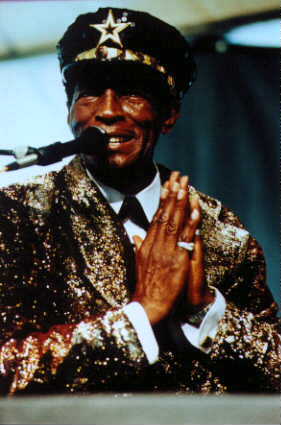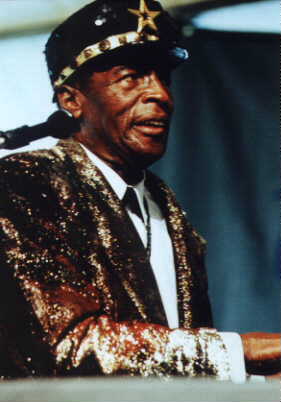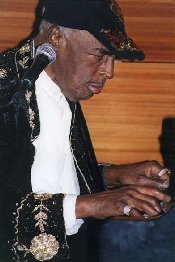



Charles Brown
Charles was wearing a cap and cape with some intricate gold threading designs on them -- almost regal in appearance. He likes to be remembered. He said "T. Bone Walker had gone to California from Texas, and he jazzed up the blues in a sophisticated way. He was very classy - he wore tails and looked great - and that's what we wanted to be. We didn't want to go up on sage with those old pants and a straw hat. I was always one of the best dressed band singers at that time, Nat King Cole and me. Even now, I don't go before the public without some flashy thing to make them remember me. People want to see a little glitter."
Instead of taking the same route as Muddy Waters and Howlin' Wolf - delta bluesmen who electrified the southern blues, Brown moved to California in 1944 and was influenced by a different sound. He blended his roots with the sophisticated jazz encountered on the west coast. The smooth blues and jump blues they they were developing pointed the way to the R&B and rock and roll to come.
Shortly after moving to California he won an amateur contest held at the Los Angeles Lincoln Theater by playing two songs, a boogie woogie and a classical composition. This led to a job with the theater's house orchestra and some local gigs where he was heard by Johnny Moore who was looking for a piano player and vocalist to join his trio, the Three Blazers. He went on to immediate success with the recording of his signature tune "Drifting Blues" in 1946.
No one personified the smooth jazz tinged blues better than Charles Brown. When he recorded this seminal hit "Drifting Blues" he said he won an award for the best blues song since "St. Louis Blues." He said he "won the award but didn't get no money." Well the National Endowment for the Arts made up for that in September of this year when they honored him with their award and a check for $10,000.
Charles Brown continued as an important player in the development of this new smooth and sophisticated mellow style of cocktail blues. On his own in 1948 he continued with a string of top ten hits on the R & B charts and was a strong influence on a young Ray Charles.
He remained on the top of R & B charts through the early 1950's then was hit by Rock n' Roll and was not heard much through the 1960's and 70's. He started getting more attention again during the late 1980 and Bonnie Raitt had him open her 1990 tour bringing his smooth blues to a whole new generation of blues fans. He has been riding high ever since with several more well received albums and constant touring to some well deserved recognition. In 1989 he received the Lifetime Achievement Award from the Rhythm and Blues Foundation and in 1997 the Nation Endowment for the Arts Award.
@ The Dakota Bar & Grill, October 15, 1997
Charles Brown performed before six sold out shows recently at the Dakota to some serious Twin Cities blues and jazz fans. He was joined by his long time band featuring the phenomenal Danny Caron on guitar, Ruth Davies on stand up bass, Deszon Claiborne on drums and the legendary Clifford Solomon on sax (with three o's, Solomon said). This combo has to be one of the best around! Brown plays a jazzy, sophisticated, smooth, after hours, cocktail-piano-blues that is almost a lost art today. His silky smooth, laid back vocal delivery is nicely balanced by his incredible piano skills.

Dakota Bar & Grill
Photo © 1997 by Steve Felling
All rights reserved. Born in Texas in 1922, Charles Brown was raised by his grandmother who started him on the piano at age 6. Classically trained, he also loved the boogie woogie and gospel sounds heard on records and in church. He recalled hearing some jazzed up hymns at church when he was young and asked his grandmother "can a piano sound like that?"
Born in Texas in 1922, Charles Brown was raised by his grandmother who started him on the piano at age 6. Classically trained, he also loved the boogie woogie and gospel sounds heard on records and in church. He recalled hearing some jazzed up hymns at church when he was young and asked his grandmother "can a piano sound like that?"
Brown related an amusing story about that. When they called "I hung up in his face," said Brown, "because I thought it was some hustler saying I won a car or something, but then you have to buy something first and you never get the car." After repeated attempts Brown was finally convinced and went to Washington DC to accept the award and money. "The money was nice, Brown said, "but I never worried about money too much. We were a poor family and these awards are not just about the money; these things are tokens of respect. It lets people know before you pass away that you were a part of the history of American music. It's important, because in the olden days, you paid so many dues and you weren't recognized. You want to leave a legacy. I want people to know that I was part of making up these rhythm and blues."

Dakota Bar & Grill
Photo © 1997 by Steve Felling
All rights reserved. Many of the songs he performed at the Dakota had that slow, melodic, moody, melody that just oozes with atmosphere. These were songs that evoke the mood of the lyrics with his smooth-as-silk sounding voice helping to create this mood as much as his jazze tinged keyboard stylings. Songs like "Bad, Bad Whiskey," the remarkable "When Did You Leave Heaven," and "Merry Christmas Baby," that had an almost big band sound to it with the stellar arrangement by his combo. He also played some nice boogie woogie piano that rocked the joint. Throughout the night there was some great inter-play between piano, sax, guitar and rhythm section. On one song, the saxophone playing, by the fabulous Clifford Solomon, was following Brown's vocals note for note, with the piano adding a nice subtle counter point. After 50 years the legendary Charles Brown still has that fire in his belly and that delicate touch in his hands.
Many of the songs he performed at the Dakota had that slow, melodic, moody, melody that just oozes with atmosphere. These were songs that evoke the mood of the lyrics with his smooth-as-silk sounding voice helping to create this mood as much as his jazze tinged keyboard stylings. Songs like "Bad, Bad Whiskey," the remarkable "When Did You Leave Heaven," and "Merry Christmas Baby," that had an almost big band sound to it with the stellar arrangement by his combo. He also played some nice boogie woogie piano that rocked the joint. Throughout the night there was some great inter-play between piano, sax, guitar and rhythm section. On one song, the saxophone playing, by the fabulous Clifford Solomon, was following Brown's vocals note for note, with the piano adding a nice subtle counter point. After 50 years the legendary Charles Brown still has that fire in his belly and that delicate touch in his hands.
![]() E-mail Ray Stiles at: mnblues@aol.com
E-mail Ray Stiles at: mnblues@aol.com
Table of Contents:
Return To Home Page | Calendar | Spotlight | Live Reviews | New Reviews | Photo Gallery
CD Reviews | New CD Releases | Blues Links | Blues Bios | Blues Artists | Blues Clubs | Blues Jams

